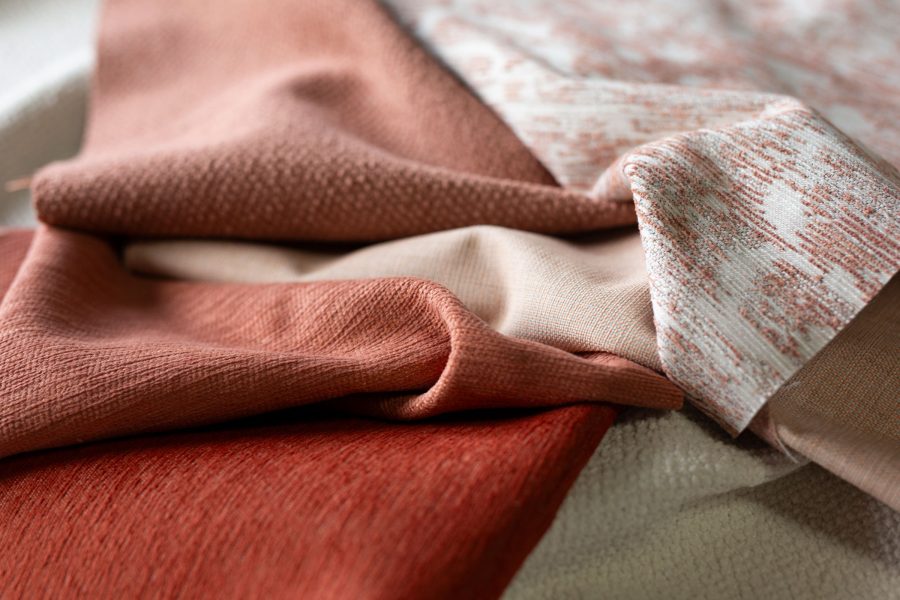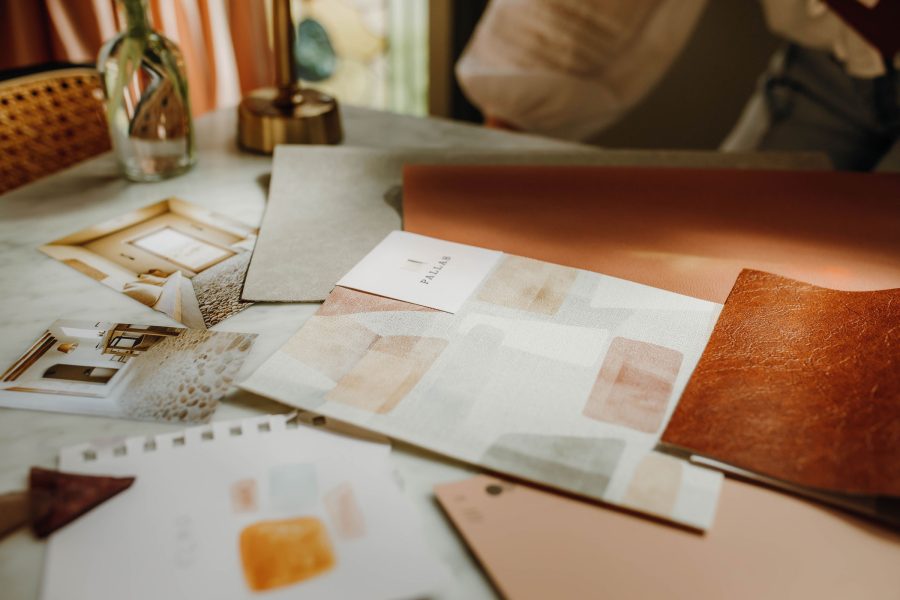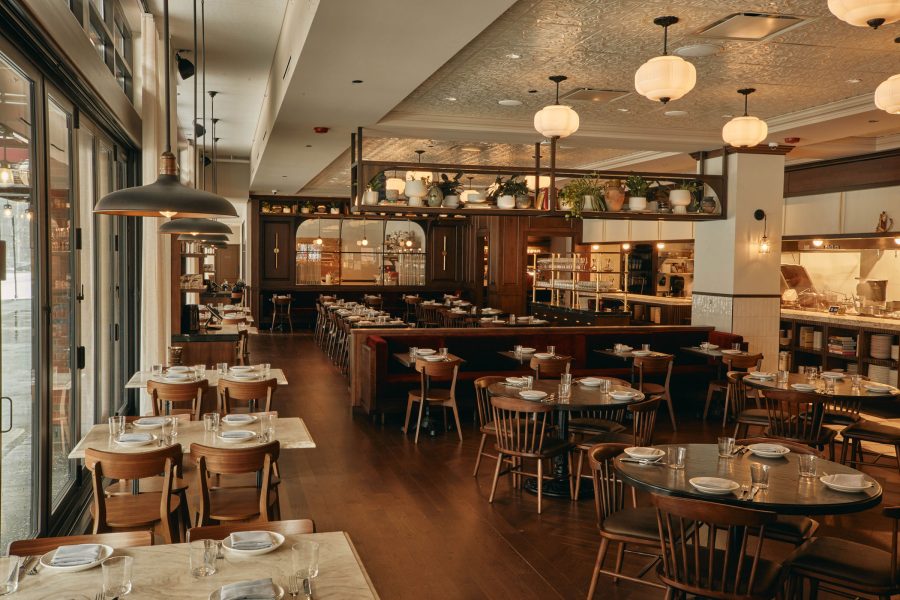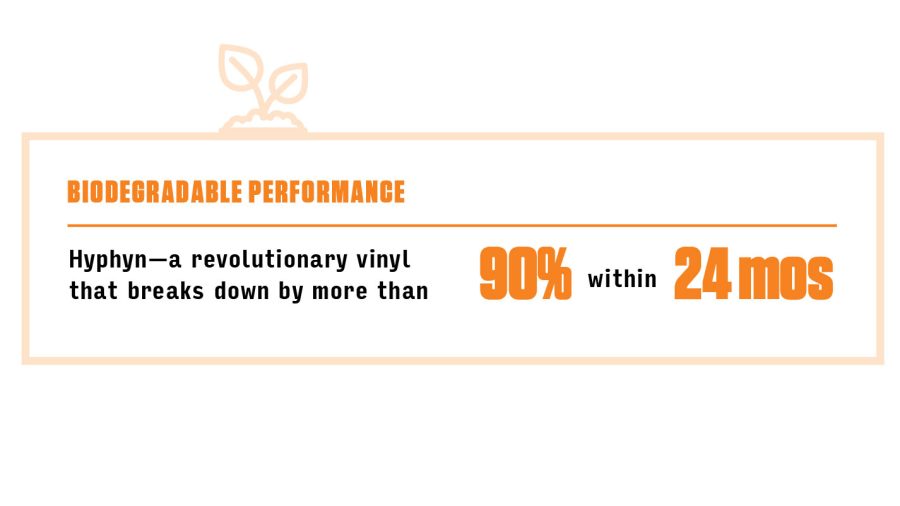Story at a glance:
- Pallas Textiles is continually innovating and educating the industry. The company’s Reve Collection celebrates sustainable sourcing, creation, and biodegradability, completely changing the vinyl landscape.
- Reve includes seven looks made entirely with Hyphyn—a revolutionary biodegradable performance vinyl that breaks down by more than 90% within 24 months in landfill conditions.
Refined designs are pushing textiles to show up in new and big ways across hospitality, especially as hotels and other properties compete to grab attention. “When you first walk into a space, what does it look like? What does it feel like? What’s the vibe?” asks Dean Lindsley, vice president of Pallas Textiles, a global leader in intentional textile design since 1989. “All these brands are looking to create something aspirational for their clients to connect with.”
While Pallas Textiles still designs textiles that are popular on headboards, footboards, and task chairs, they’re finding increased demand for bigger and bolder uses in areas like the hotel entrance. “We’re seeing a lot more of these materials being specified for the statement lobby,” he says. “There’s a much higher level of design that’s expected and required, not just for the brand, but think about the competition within that particular market.” Hotels are trying not just to get customers’ attention for one stay, but for years to come.
There’s a much higher level of design that’s expected and required.
Pallas is proud to lead the transformation of hospitality environments, turning ordinary spaces into memorable places that spark emotion and connection. “We’re not just waiting for an opportunity; we’re actively shaping the initial lobby experience when guests walk into a Marriott, a Hyatt, or a boutique hotel, and we’re doing this with clean and sustainable materials,” Lindsley says. “That’s what excites us at Pallas—creating environments that truly resonate and leave a lasting impression.”
It’s not just 4- and 5-star properties stepping it up, either. Lindsley says the demand exists for 3-star hotels, too. “They’re really wanting to raise the level of design in their spaces. Where in the past they maybe weren’t as focused on materials, the statement they could make within the spaces, and how that reflected upon their brands, there’s been a significant shift toward every brand looking to raise the bar.”
Innovative Solutions

Pallas Textiles’ In Good Company collection features six styles woven with SEAQUAL YARN containing upcycled marine plastic. Photo courtesy of Pallas Textiles
Considering that hotels and restaurants experience frequent remodeling, manufacturers like Pallas have to increasingly consider how to create impactful designs that won’t harm the environment. In spring 2025 Pallas unveiled its latest innovation—the Reve™ Collection. Made with a biodegradable performance vinyl called Hyphyn, the Reve Collection includes seven patterns designed to biodegrade by more than 90% within two years in landfill conditions, leaving behind no microplastics or toxic residues.
“The Reve Collection offers an industry-first, clean biodegradable vinyl,” Lindsley says, emphasizing the word “clean.” “If we take a step back and take a look at legacy products, you could technically say they were biodegradable, but they were far from clean. Reve transforms industry, where we have an industry-first, clean biodegradable vinyl—and one that biodegrades in a small window of time compared to the legacy products.”
Lindsley says the groundbreaking solution is the result of more than two years in R&D as well as third-party testing before bringing Reve to market. Both it and another collection, In Good Company™, are part of a broader strategy to create products that are not only mindful but beautiful, he says. In Good Company features six styles woven with SEAQUAL YARN made from upcycled marine plastic.
Industry Insiders

Reve includes seven looks made entirely with Hyphyn—a revolutionary biodegradable performance vinyl that breaks down by more than 90% within 24 months in landfill conditions. Photo courtesy of Pallas Textiles
Architects are seeing an increased demand for sustainable materials like these in projects. Companies see the value in sustainability and want to market their properties that way, according to Joe Junius, who’s spent 19 years with architecture and design firm Aria Group and is now a part-owner. Aria specializes in hospitality and entertainment design and says more people, especially among younger generations, want to spend time in places they feel are better for the environment. “We’re seeing a lot of restaurants and big-brand hospitality starting to realize that,” Junius says.
He says some hospitality brands have also started using MindClick, which rates the environmental health performance of manufacturers and their products. When manufacturers promote their materials’ sustainable attributes, that helps architects and designers to specify and better understand what they’re putting into projects, Junius says. “It’s adding power to our arsenal as we suggest materials.”
Aria has seen impressive material innovation in recent years, Junius says. They use textiles for a lot of booths, banquettes, and draperies in restaurants, and they’ve seen a demand for materials other than leather, for instance. “Everyone loves leather, but the maintenance and durability of it has always been a concern,” he says. He says designers are also trying to get away from traditional vinyl and, as a result, a lot of innovation is happening.
“Pallas has a biodegradable vinyl, which is really awesome, especially for a restaurateur,” Junius says, citing the frequent remodels or changeovers in hospitality. “Upholstery and textiles seem to be changed out quite frequently. Ideally you have the ability to not just throw it into a landfill, but if you do have to throw this in the landfill, for it to be biodegradable, then you don’t feel that on your conscience. There’s a lot of innovation, and it’s great to see.”

Aria Group designed Il Carciofo using many sustainable design strategies, including using GREENGUARD-certified materials and products with Declare Labels. Pallas Textiles can be found among the banquettes and draperies. Photo by Matt Haas, courtesy of Aria
He says sustainable materials are more accessible than ever, even when it comes to pricing. “The cost is coming down because more people are cognizant about it, which is a good thing. And because more people are cognizant about it, they’re asking questions all the way to the operators. Then the operators are saying, ‘Hey, if I build this place and use it as marketing to say this is a very sustainable property, that helps drive traffic to me,’” Junius says.
Sustainable design strategies are plentiful at the Aria Group–designed Il Carciofo project in the upscale Fulton Market neighborhood in Chicago. The Italian restaurant opened on the ground floor of a WELL-certified building, with 100% LED lighting and an emphasis on GREENGUARD-certified materials and products with Declare Labels, Junius says. Pallas Textiles can be found on the elegant banquettes and among the draperies.
Sustainability is Here to Stay

“Sustainability is and has always been a core brand principle to Pallas,” says Dean Lindsley, vice president at Pallas Textiles. “Our opportunity is to create textiles that are not just beautiful and functional, but they’re also responsible.” The Reve Collection is seen here.
While hospitality is always reinventing itself, Junius says sustainability is no trend. While some may have thought it was at first and were reluctant to make big moves, there’s no denying the momentum today, he says. “We’re going to see more and more emphasis on how things are disassembled or deconstructed or biodegradable,” he says.
“We’re consistently innovating to find new, responsible ways to design spaces,” he says. “Life cycle is also super important.” He says it’s the designer’s responsibility to try to create something more timeless, so that even if a restaurant changes over, some of the elements can stay, allowing for less waste and cost in the future. “That’s something we always try to do, trying to create more of a timeless design so that in the not-too-distant future when something does get changed, you don’t have to bulldoze the whole place.”
Brands like Pallas are also focused on enduring designs. “We’re designing not just for now, but we’re constantly looking into the future and at what the next generation of materials and materiality is,” Lindsley says.
Bio-based and bio-attributed materials are a big part of the discussion at Pallas. “We’re very committed to closed loop solutions, textile solutions, and we look to minimize waste and ultimately extend the life of our planet’s valuable resources. That really includes incorporating upcycled and recycled fibers like cotton, wools, and post-consumer plastics,” Lindsley says. “It’s a circular strategy that enables us to reduce our environmental impact, ultimately meeting the high-performance demands of our design community and support a more regenerative future for the industry while aligning with a growing expectation.”
Informed Decisions

Graphic by Michael Esposito
It’s not just the design community who’s demanding more environmentally friendly solutions; end users are far more engaged than ever, too, Lindsley says. “There’s a thirst for insight and knowledge. They’re not just asking if a product is sustainable anymore. It’s not just a label. They really want to know the how and the why. They want to dig into the details because the details matter.”
Pallas’ role is to provide those material solutions that support their objectives, and that’s where things like circularity, transparency, and renewable material sourcing becomes critical.
In particular Pallas Textiles has seen a really strong shift toward ESG goals in hospitality, with more third-party certifications and the data to back up the claims behind sustainable spaces. “Third-party metrics are really influencing everything from how products are procured to how those hospitality brands are looking to integrate this into their brand and their storytelling. How do they differentiate themselves and align themselves with what their audience finds as meaningful? Pallas’ role is to provide those material solutions that support their objectives, and that’s where things like circularity, transparency, and renewable material sourcing becomes critical.”
Pallas integrates sustainability into every step of its creative process, from where they source raw material to end of life considerations. Collections like In Good Company, with its upcycled marine plastic, tell a design story that’s more than just about beauty and high performance; it also tells a story of reclamation and oceanic conservation.
Lindsley says Pallas will never stop innovating and never settle for the status quo. “Innovation doesn’t happen in a vacuum; it really happens when we ask the ultimate question: What can we do to be better—and to be better together?

